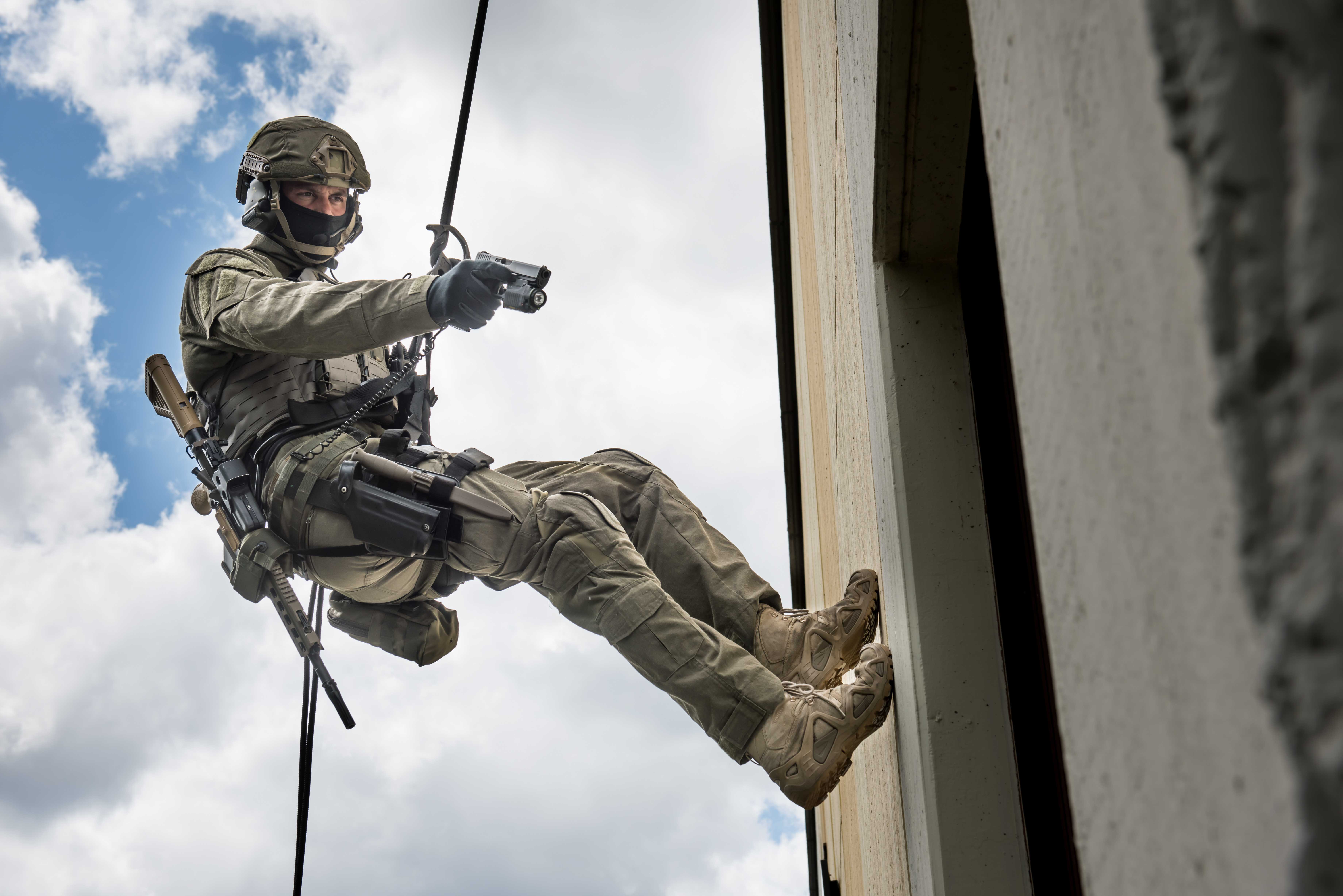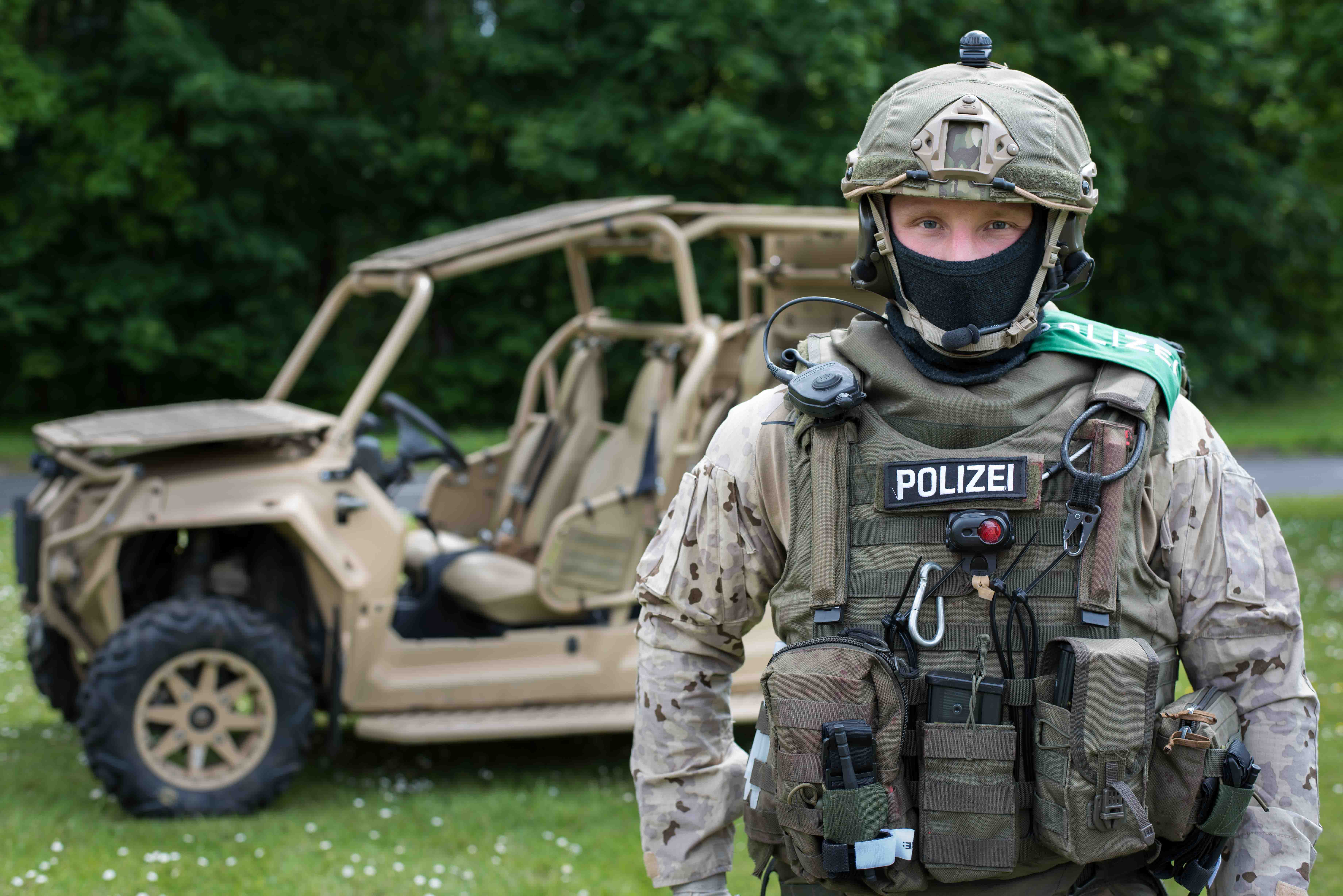Ahead of the release of his latest book for Osprey, The Elite: The A–Z of Modern Special Operations Forces, we asked author Leigh Neville to tell us about some of the units included in The Elite. In this series of five blog entries, Leigh looks at his personal top five military or police special operations forces (SOF).
Number 4
Grenzschutzgruppe 9 (GSG9)
Grenzschutzgruppe 9 (Border Protection Group 9), more commonly referred to by its acronym GSG9, is undoubtedly one of the world’s finest counter-terrorist (CT) intervention units. One of the reasons for this is that GSG9 was literally one of the first modern CT units to be formed following the hostage-taking at the 1972 Munich Olympics and the disastrous attempt by West German police to intervene – it paved the way for all others to follow by developing techniques and tactics that were the genesis of modern counter-terrorism.

A 2017 image of a GSG9 operator rappelling down a building. He is armed with a 9mm Glock 17 pistol and slung 5.56mm HK416 carbine.
Image courtesy of Bundespolizei
GSG9 was established in October 1972 with responsibility for ‘…the liberation of hostages; to put especially dangerous and active criminals out of action, such as plane hijackers; the warding off of terrorist acts, carried out with firearms, explosives, or incendiaries; protecting criminal court procedures with a high grade of danger and interference attached; other criminal acts which necessitate a forcible elimination of delinquents, groups of criminals, or the clearing out of hiding places; concrete security measures on the personnel and material side.’
Wary of comparisons to wartime German military units, the unit was formed under the control of the West German Federal Border Guard Service rather than the Bundeswehr and operators were drawn from police ranks. Assisted by the British Special Air Service (SAS) – who themselves had only formed a fledgling CT capability that year – and Israel’s Sayaret Matkal/Unit 269, GSG9 was formally activated in April 1973.
GSG9’s first, and still best known, mission set the standard for counter-hijacking operations when the unit successfully resolved the 1977 terrorist hijacking of a Lufthansa airliner that was eventually flown to Mogadishu, Somalia. With only limited equipment (including a lack of enough body armour and helmets to equip the whole team), GSG9 stormed the aircraft and killed three of the four hijackers. The fourth was wounded but survived. All 86 hostages were rescued with only a handful suffering minor wounds.
A curious aside to the operation was the inclusion of two SAS observers who accompanied the team and offered the use of then-recently developed ‘flashbang’ stun grenades. These were tested by GSG9 but not ultimately employed as the risk of fire within the aircraft from the devices detonating was considered too great.
Operation Feuerzauber (Fire Magic) placed GSG9 on the world-stage as recognised masters of counter-terrorism intervention, a distinction that continues today. Much like the majority of European CT units, GSG9 operates against both armed criminals and terrorists and has conducted thousands of missions in the almost five decades since its inception. In that time the unit has lost only three operators, two killed in Iraq conducting close protection for German officials and one killed during the pursuit of a notorious Red Army Faction terrorist.

A GSG9 operator equipped for operations in arid environments such as recent missions to Mali, standing in front of one of their Polaris MRZR off-road vehicles.
Image courtesy of Bundespolizei
GSG9 was one of the founding members of the ATLAS Network, a pan-European CT coordination organisation to share tactics and techniques. Each year ATLAS holds a major exercise involving all member units with multiple terrorist simultaneous terrorist scenarios. Each unit provides specialist advice on one key operational aspect and for GSG9 that is maritime counter-terrorism (MCT). Unlike many nations, Germany does not employ a specific MCT unit. Instead GSG9 is divided into four distinct specialist elements.
GSG9/1 is the hostage rescue intervention unit and contains the unit’s snipers; GSG9/2 comprises the unit’s maritime specialists working with small boats and SCUBA infiltrations; GSG9/3 contains the parachutists, skilled in MFF (military free-fall), HAHO (high altitude high opening) and HALO (high altitude low opening). A new contingent trained in CBRN (chemical, biological, radiological and nuclear), GSG9/4, was established in 2017.
The unit epitomizes world-class professionalism in counter-terrorism and is rightly lauded for its meticulous planning, leading-edge operational research and innovation, and tactical restraint (despite thousands of operations, GSG9 has fired shots in anger on only a handful of occasions). Its leadership position in the ATLAS Network has ensured that its considerable knowledge and experience has been shared across Europe (it also maintains close links with the US Army Delta Force amongst other international units including the Israelis).
Check out Leigh's previous blog post about his fifth choice here.
The Elite: The A–Z of Modern Special Operations Forces publishes 28 November 2019. Preorder your copy here.


Comments
You must be logged in to comment on this post. Click here to log in.
Submit your comment